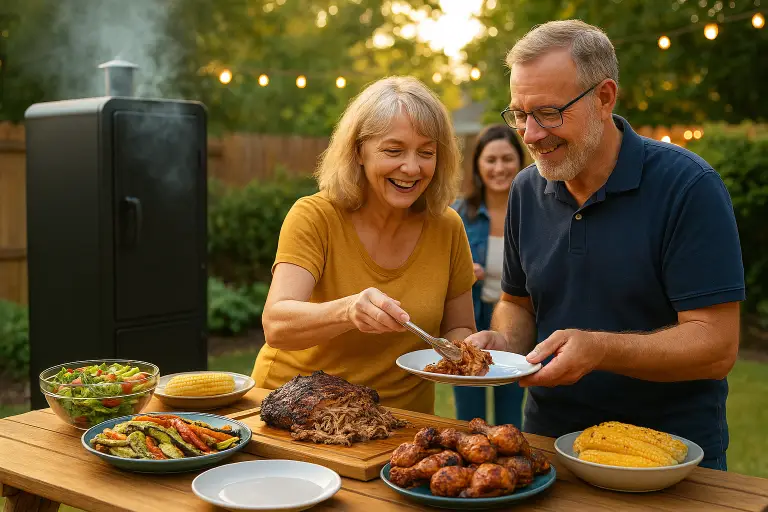You’ll hear pitmasters say “chase thin blue smoke.” They’re right. Thin, almost invisible blue smoke usually means clean, efficient combustion and a subtle, sweet smoke flavour. Thick, white/grey billow often means smouldering, wet or oxygen‑starved fire that can lay down sooty, acrid compounds on your food. Here’s the plain‑English version of the why and how, plus quick fixes for electric smokers.
What each smoke colour is telling you
- Thin blue (or nearly invisible) smoke → wood gases burning cleanly with enough heat and oxygen; flavours are gentle and bright.
- White, billowy smoke → steam and unburned particles from cool, wet, or smouldering fuel; can taste ashy, sharp or bitter.
- Dark grey/black → incomplete combustion or grease fire; move food away and get airflow under control.
Aim for light, wispy, faintly blue smoke before loading meat. On many pits it appears after the initial startup clouds settle.
Why blue = better (short science)
Wood releases complex gases as it heats (pyrolysis). With enough heat + oxygen, those gases combust cleanly, making a paler, bluish plume. Starved of air or cooled by moisture, they condense into visible white clouds and creosote‑heavy deposits that taste harsh.
How to get thin blue smoke (any smoker)
- Preheat fully so the firebox/chip tray is hot.
- Airflow first: keep the exhaust/top vent open and control heat with intake or fuel amount—not by choking the exhaust.
- Use dry wood (seasoned chips/chunks). Skip soaking: it adds steam and cools the fire.
- Small, frequent additions of wood rather than a big load that smoulders.
- Don’t smother the fire with ash, grease, or a packed chip tray; empty and clean regularly.
- Wait for clean smoke after you add fuel—then add meat.
Dialling it in on electric smokers (Masterbuilt 710, etc.)
- Vent wide open. Electrics already run humid—let smoke move through rather than linger.
- Handful of chips at a time (e.g., each 45–60 minutes). Overfilling the tray makes it smoulder and go white.
- No soaking chips. Wet chips create steam and cool the heater; you’ll get white plumes and slower ignition.
- Preheat the cabinet and the chip tray so chips ignite near‑immediately.
- Keep the water pan modest (or dry) once bark is set; too much humidity slows combustion at the surface.
- If smoke turns white: pull the tray, dump spent chips/ash safely, reload lightly, reopen the vent, and give it 5 minutes to clear.
New to electrics? Read our review: Masterbuilt 710 WiFi Digital Electric Smoker (UK) for real‑world behaviour.
/electric-smokers/masterbuilt-710-wifi-digital-electric-smoker-review-connected-smoking-for-the-uk-bbq-scene/
Don’t soak your wood (why that advice lingers)
Soaking chips/chunks doesn’t meaningfully hydrate hardwood; water only dampens the surface. When you throw wet wood on the heat, the water must boil off first (steam = white clouds), cooling the fire and delaying clean combustion. Use dry wood and control the burn with airflow and amount.
Quick fixes for white, billowy smoke
- Open the exhaust fully; slightly increase intake air if you can.
- Reduce the fuel load (too many chips/chunks smoulder).
- Swap in dry fuel; avoid green/sappy wood.
- Clean out ash blocking airflow.
- Give it 5–10 minutes to stabilise before putting meat back on.
“How much smoke is enough?”
You don’t need constant visible smoke for hours. Many cooks find the best flavour comes from clean smoke early on, then occasional, light refreshes. If you can smell a pleasant wood aroma at the exhaust without eye‑sting, you’re likely in the sweet spot.
Troubleshooting flavours
- Bitter/ashy finish → heavy white smoke, vent closed, or soaked/green wood. Fix airflow and fuel.
- Too little smoke flavour → teeny fuel amounts or wood spent; add a small fresh charge once the plume clears.
- Sooty bark → smoulder or grease flare; clean the tray, mind drippings, and stabilise to a light plume.
Handy tools & internal links (live on your site)
- BBQ Smoker Time Calculator & Cook Planner — plan stages, then cook by probe & feel:
/bbq-smoker-time-calculator/ - Kitchen Calculators (Brine + Yield) — % brines in grams and raw→cooked yields:
/brine-calculator/
FAQs
Should smoke be visible the whole cook? Not necessarily. If it smells sweet and woodsy and you see a faint wisp, you’re fine. Thick white for hours is a red flag.
Why does smoke turn blue after startup? Early combustion is cooler and steamy; once the fire and oxygen balance stabilise, particles shrink and gases burn more completely → thinner, bluer smoke.
Is “clear” smoke OK? Yes—if you still smell clean wood at the stack. Food continues to pick up flavour without big visible clouds.


